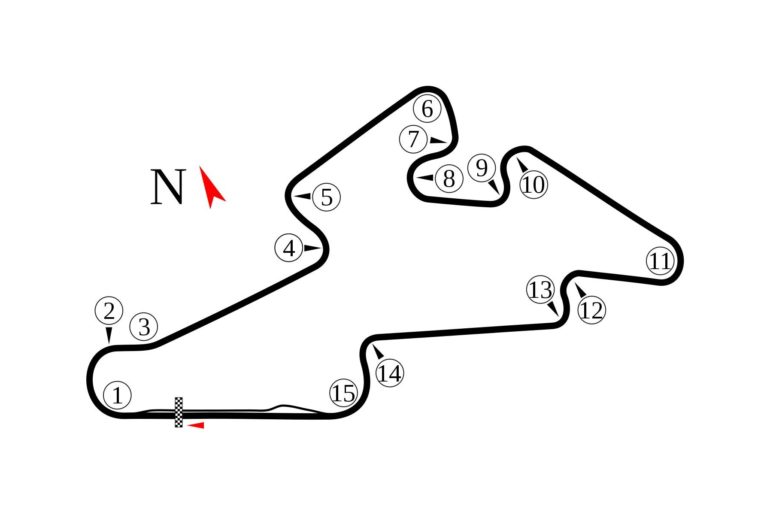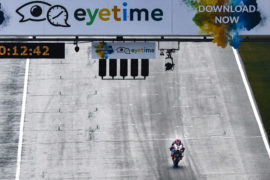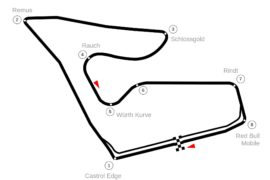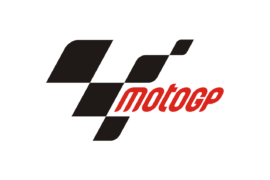There are modern tracks on the MotoGP calendar, and there are old tracks. The modern tracks offer plenty of run off and nice wide tarmac, but are usually too tight and convoluted to give free rein to a MotoGP bike.
The old tracks are fast, flowing, offer plenty of overtaking opportunities, and are a real challenge, but they also tend to be narrow, and, frankly, dangerously lacking in run off. The riders find the new tracks irritating, but enjoy the safety, and they love the old tracks, but fear the consequences of a bad mistake.
The Automotodrom Brno seems like the perfect compromise. Fast and flowing, challenging, and big enough to give a MotoGP bike its legs. But also wide, with plenty of run off in most places, and plenty of grip from the track.
It has a stadium section, giving fans the chance to follow the action through a section of track. But it also flows up and down a hill, and through the woods, a ribbon of tarmac snaking through a beautiful natural setting, high on a hill above the city of Brno.
That location offers its own challenges. Up on the hill, it is usually a little cooler than down in the town. The woods exhale oxygen which gives the bikes a little power boost.
But they also hold moisture, the combination of high hills and thick woods raising the possibility of rain. Fortunately, the track retains its grip in the wet, though the rain can still shake up a race.
Every Type of Challenge
Riders and bikes face an entertaining range of challenges at Brno. Some hard braking sections, especially at Turn 1 and Turn 3, but more importantly, a flowing layout. The track is rife with combinations of corners, the perfect recipe for motorcycle racing.
You can pass another rider going into most corners, but if you do, you leave yourself open to counterattack as the track comes back on itself. Pass into Turn 4, and you leave yourself open through Turn 5.
Have a go at Turn 6, and the rider you passed has the entire stadium section to come back at you. Have a go up the hill at Turn 12, and they can come back at Turn 13. And of course there’s the final death-or-glory chicane before the finish line.
Above all, there is the hill, dubbed Horsepower Hill for its steepness. The TV footage does not do it justice, but seeing photographers struggling to get a scooter laden with cameras and lenses up the hill makes you realize just how tough that incline is.
If your bike is down on horsepower, you need to make sure you start the hill ahead of your rivals, so you can hold them off through the chicanes.
Fear the RC213V
The extra horsepower Honda have found for the RC213V does not bode well for anyone hoping to call a halt to Marc Márquez’s seemingly relentless march towards the 2018 MotoGP title.
More horsepower for the 2018 bike has made it a lot more manageable, taking away the need to risk it all in braking. More horsepower will also help haul the Honda up Horsepower Hill, and put the bike in a good position for the finish line.
Márquez won here last year, though more through a masterstroke of strategy, coming in after two laps to swap to slicks as the track started to dry, where the rest of the field stayed out much longer on wet tires, only to find that Márquez had already built up a huge lead.
The Honda was already strong at Brno. Honda have won six of the last seven races at the track, with Marc Márquez, Dani Pedrosa, Cal Crutchlow, and Casey Stoner all taking victory there.
Dani Pedrosa has been exceptionally strong at Brno, beating Jorge Lorenzo in a tight victory twice, and only losing out to his teammate by three tenths of a second in 2013.
It was Pedrosa who put an end to Márquez’s run of 10 straight wins at Brno in 2014 as well. If there is a track where Pedrosa can get his season back on track, and push for a win to keep his record of consecutive seasons with a victory intact.
Honda may have dominated at Brno recently, but the layout of the track suits Yamaha down to the ground. Fast changes of direction and places where corner speed is king play to the strengths of the M1, as witnessed by the strong results the factory has booked in the past.
Yamaha won three-straight races between 2008 and 2010, Valentino Rossi winning twice, Jorge Lorenzo winning in 2010, while Lorenzo won again in 2015.
Lorenzo finished just behind Dani Pedrosa in both 2012 and 2014, and Valentino Rossi has been a frequent podium visitor, despite not winning at the track since 2009.
Victory needed
Yamaha need a win. The Sachsenring made it 19 races without a win for Yamaha, their longest winless streak since 1998.
The issue has been tire wear, especially in the second half of the race, and both Valentino Rossi and Maverick Viñales have been very vocal about Yamaha lagging too far behind with the electronics of the M1.
Yamaha have brought what Rossi described as a “small step” to Brno, to be debuted at the test on Monday. “We have some small step in this period, I think, but they need time,” the Italian told the press conference.
“They need time to have something bigger, so they need more time. We speak about different areas but mainly it is electronics, yes.”
They face the additional challenge of fending off the Ducati. Horsepower has always been a strength of the Desmosedici, and Brno is a track where they can reap the benefits of the copious quantity of ponies housed within the cowling of Ducati’s machines.
Nothing will beat the Ducati up Horsepower Hill, but first they have to navigate the fast switchbacks which line the Brno track.
Luckily, Ducati have a number of things going for them. First and foremost, perhaps, that Jorge Lorenzo is on a bike, and is much more competitive than last year.
The aerodynamic fairing debuted at this track last year transformed his fortunes, and added to the revised chassis and extra support from a reshaped tank pad, should put him in the mix from the start.
Lorenzo got a strong start in 2017, and if it hadn’t been for a botched bike swap in a flag-to-flag race – still one of his weakest points – he could have been in the mix.
Aerodynamics could be important for Lorenzo’s teammate at Brno, Andrea Dovizioso set to debut a new fairing some time this weekend.
Dovizioso was another rider who struggled during the bike swap last year, though he came back to finish sixth. Ducati have strength across the board too, with Jack Miller, Danilo Petrucci, and Alvaro Bautista also capable of mixing it up at the front.
Cal Crutchlow and Johann Zarco could also make an impression at Brno. Crutchlow won here in a wet race in 2016, and had a solid race to finish fifth in 2017.
The LCR Honda rider is concerned about the allocation of front tires, especially, as usual, worrying that the tire is not hard enough to cope with the stresses involved. The key to managing that, he believes, is to get out in front and get cool air on the front tire, to prevent it from overheating.
Fences Mended
As for Zarco, the Frenchman has effected something of a reconciliation with his now former manager Laurent Fellon. The friction between the two had been at least part of the cause of his drastic drop in performance in recent races, Zarco not being a shadow of the rider he was in the opening races of this season.
Zarco laid at least some of the blame on himself, he told the media at Brno. Who had he been speaking to during the all-too-brief summer break?
“First of all with myself,” the Monster Tech3 Yamaha rider said. “Then with Laurent when we were having some training with Supermoto. And now with the team. The first one I was speaking to was myself.”
Riding with Fellon again had been good, Zarco said. “With Laurent, the special thing is that when we are training, we are on the track alone with the motorbike, we have kind of special feelings together,” the Frenchman philosophized.
“I like it, and I want to still use it and work in this way. I feel it can make me still strong, even in the future. Because I am growing up, progressing with my career, a few things need to change, like a child growing up.”
“That’s why people think we are fighting or struggling together, but we are just changing a bit the way of managing but not how we are working on the track.” Fellon was still his coach, Zarco explained, but no longer his manager.
Could Suzuki mount a challenge at Brno? The bike has the agility and the corner speed to cope with the fast sweeping corners at the circuit. This year, it also has the horsepower to handle the hill, though it is still shy of the Ducati’s numbers.
The challenge will be for the riders, as neither Alex Rins nor Andrea Iannone have a spectacular record on the Suzuki. Iannone at least has performed well at the circuit, scoring strong results in previous years on the Ducati, but neither he nor Rins have managed to reproduce that on the Suzuki.
Bigger Breaks Please
The MotoGP riders return to the track on Friday, with just two weekends between Brno and the previous race at the Sachsenring. The briefness of that break was a bone of contention for most riders, though not all (most prominent dissenting voice: Andrea Dovizioso).
Having a long break was a necessity, most riders agreed, to allow time to get away from racing, and for tired bodies and minds to recover, and to allow any injuries picked up in the first half of the season to recover.
Some riders had not even had the two weekends off: the Ducati riders had obligations at the World Ducati Weekend at Misano, making it another working weekend for them, despite the fact that it is such a remarkable event which they enjoy attending.
Takaaki Nakagami had raced the Suzuka 8-Hours race last weekend, flying back from Japan to jump straight onto another bike at Brno.
Though Dorna’s hands are tied to some extent by promoters and circuits, they will not repeat that mistake again in 2019. Next year, there will be at least three free weekends between the German round of MotoGP – probably the Sachsenring, but that is no certainty – and Brno, at the end of the summer break.
That space will be created by running Assen and Germany back-to-back, something which many riders had pleaded for in the Safety Commission.
“We’ve already spoken a little bit about this and it is important on the summer break to increase it maybe by one week more,” Valentino Rossi said.
“It was a very short summer break because for us it was like one week and a half because you need to be fit for the start of the second part of the season with two races in a row. Every year we have more races but I know Dorna is working on the calendar because I think it will be important for everybody.”
Managing the Calendar
As the calendar expands – there will be at least 19 races next year, and perhaps even 20, despite the fact that MotoGP will not be going to Finland in 2019 – scheduling becomes more difficult, with little free time left with which to create free weekends.
Valencia, the final race of the year, cannot be pushed back any later. Thanks to the revised schedule at Qatar, with the MotoGP race run at 7pm instead of 9pm, the season opener could be run much earlier than it is now, perhaps as early as the first week of March, though officials involved in scheduling refuse point blank to answer any questions on the precise start and end date of the season.
An option preferred by the riders is to have more races in Europe run back to back. With travel time relatively limited, and no change in time zones, two or even three races could be run on consecutive weekends, opening up a hole in the schedule for a summer break.
That would suit the teams and riders, giving them time to rest, and perhaps even test in the middle of the break, and it may help with TV coverage, as late June and July often have major sporting events going on which interfere with coverage of MotoGP.
It could also help some circuits, who would not have to contend with fans being on vacation over the summer, rather than taking a break to attend a race.
The calendar of winter testing should be announced any day now, but the 2019 race calendar could take more time to assemble. There are still questions to be answered and choices to be made, but one thing is for certain: there will be some form of summer break next year.
Everyone is glad to be back at a race track again. But with a long second half of the season ahead of us, their joy would have been greater if they had been given an extra week at home, to prepare them.
This article was originally published on MotoMatters, and is republished here on Asphalt & Rubber with permission by the author.




